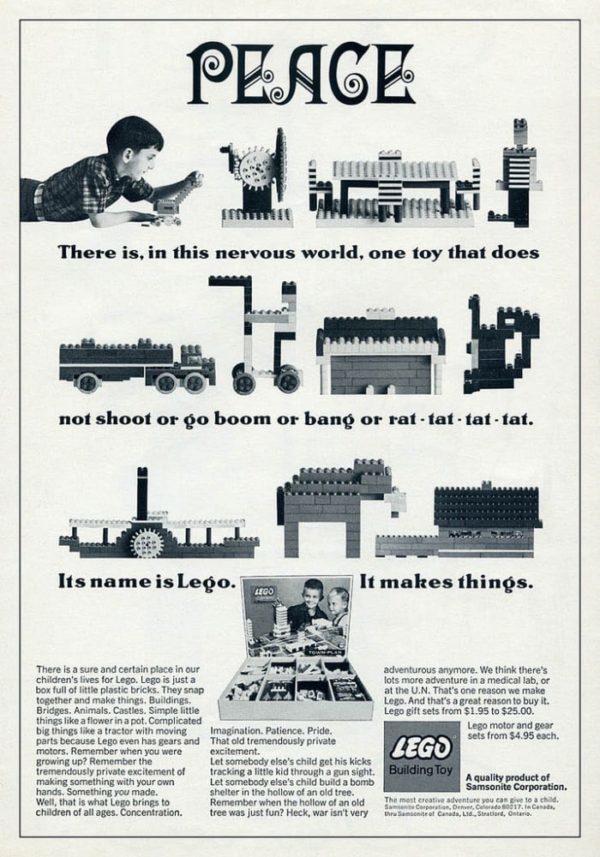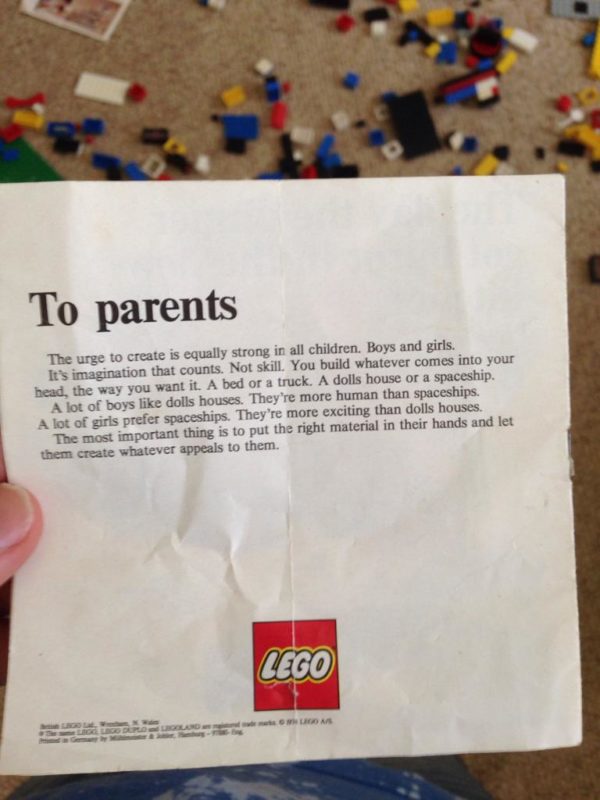
I read about this 1966 LEGO ad in Alexandra Lange’s The Design of Childhood. In case you can’t read the copy:
Let somebody else’s child get his kicks tracking a little kid through a gun sight. Let somebody else’s child build a bomb shelter in the hollow of an old tree. Remember when the hollow of an old tree was just fun? Heck, war isn’t very adventurous anymore. We think there’s lots more adventure in a medical lab, or at the U.N.
A half century later, it seems remarkably progressive . I was reminded of this pamphlet from a 1974 LEGO set:

The urge to create is equally strong in all children. Boys and girls.
It’s the imagination that counts. Not skill. You build whatever comes into your head, the way you want it. A bed or a truck. A dolls house or a spaceship.
A lot of boys like dolls houses. They’re more human than spaceships. A lot of girls prefer spaceships. They’re more exciting than dolls houses.
The most important thing is to put the right material in their hands and let them create whatever appeals to them.
Again, it seems remarkably progressive, as does this 1981 ad, written by creative director Judy Lotas, who was inspired by the Equal Rights Amendment and her own daughters:

Have you ever seen anything like it? Not just what she’s made, but how proud it’s made her. It’s a look you’ll see whenever children build something all by themselves. No matter what they’ve created.
That ad went viral in 2012 when LEGO started marketing LEGO Friends.
The response, when we see these ads, is often, “Why on Earth don’t they do it like this anymore?”
Many parents, including myself, lament the fact that there used to be more emphasis on free play and building from imagination, rather than pre-determined kits. Here’s Raul Gutierrez, of Tiny Bop:
The best toys — Tinkertoys, Lego, Play-Doh, Lincoln Logs — allowed us to build and rebuild almost endlessly. With my kids, I noticed that these kinds of toys have become increasingly rare. Lego bricks are sold primarily as branded kits. Instead of a pile of blocks that could become anything, they are now essentially disassembled toys. Instead of starting with a child’s imagination of what could be, play is now fixed on a single endpoint, predetermined by Lego’s designers.
But Lange points out that this golden age that we think of was actually just that: a golden age, a product of the specific time:
Today, the LEGO Group is often criticized for stoking the cycle of consumer desire, sequestering LEGO bricks in individual branded universes, and launching new sets on a fashion cycle, but this has been part of the company’s sales strategy for longer than people realize. The free play celebrated in their ads of the 1970s and early 1980s reflects a brief moment in American culture when the kindergarten values — embedded in wooden blocks — returned to the forefront…
We also lament the loss of that wonderful gender-neutral tone, which, according to this NYTimes article on how Disney has branded Frozen, was way more prevalent in the 1970s than today:
Princesses may seem like a permanent feature of the toyscape, but they were less common before the 1990s. “The idea that pink princess fantasy dream dolls have always been a part of girlhood is false,” says Elizabeth Sweet, a lecturer at the University of California, Davis, who studies the cultural history of toys. Sweet has found that the popularity of gender-neutral toys reached a peak in the mid-1970s. Since then, toy makers have embraced the market-doubling effect of pushing certain toys to boys and other toys to girls. Sweet says the level of gender segregation has never been higher. A typical big-box store might have four aisles of blue toys and four aisles of pink toys with an aisle of yellow toys in between. “Separate but equal,” she says. Legos, for example, evolved from simple packs of building blocks into play sets mostly sold to boys, often with brand tie-ins. In 2012, the company introduced Lego Friends, which are basically Legos for girls.
Here’s another NYTimes article from 2012 on gender-based toy marketing:
Gender was remarkably absent from the toy ads at the turn of the 20th century but played a much more prominent role in toy marketing during the pre- and post-World War II years. However, by the early 1970s, the split between “boys’ toys” and “girls’ toys” seemed to be eroding…
But by 1995, the gendered advertising of toys had crept back to midcentury levels, and it’s even more extreme today. In fact, finding a toy that is not marketed either explicitly or subtly (through use of color, for example) by gender has become incredibly difficult.
There are several reasons gender-based marketing has become so prevalent. On a practical level, toy makers know that by segmenting the market into narrow demographic groups, they can sell more versions of the same toy.
We want, so badly, for companies to stand for something good, and some companies do, but at the end of the day, advertising is about moving product, and while it can be idealistic and a force for good, is always the product of people trying to sell things to other people in a particular time and place. If you want better, more progressive advertising, build a better, more progressive world. Best not to get too caught up in nostalgia, but look back, see what’s worth stealing, and more forward.
A note on the post title, from Lange’s book: “LEGO” is a contraction of the Danish leg godt, or “play well.”